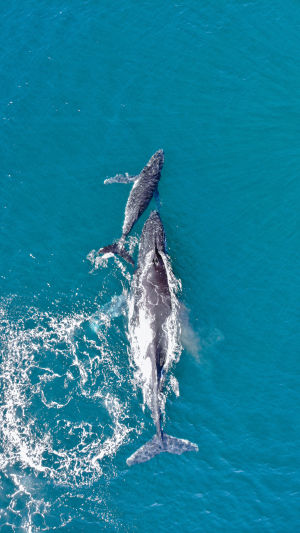On the blue planet, herd species must communicate and share information with one another.
As humans, people rely on two primary forms of communication: language and writing. people’s advanced brains and flexible articulation organs enable people to speak and express themselves freely, while dexterous hands allow people to write down unique thoughts.
However, for "sea people" living in the underwater world, language, and writing are not available tools for socializing. So, how do they communicate with one another?
Among mammalian species, cetaceans stand out for their remarkable communication abilities. These intelligent creatures are the most intelligent beings in the ocean, with scientists discovering that they use a series of whistle-like acoustic signals to communicate with one another.
Cetaceans possess a rich vocabulary and superb communication skills, earning them the title of "wise men of the sea." The humpback whale, for instance, is known for its singing ability and can sing for up to 22 hours straight. Their songs contain a variety of "words" and are mainly used to identify gender and maintain contact within their community.
Blue whales are a peaceful species found in many of the world's major oceans, including Antarctica, the Atlantic, Indian, and Pacific Oceans. Unfortunately, their populations have dwindled due to massive whaling that took place between the 17th and 20th centuries, as well as recent disturbances in their natural habitat.
Blue whales communicate using the lowest frequency of cetacean recordings, emitting loud, low moans and wails that can be heard over great distances. These "sinking" calls contain an impressive 11 different types of sounds, ranging from 107 Hz to 21 Hz or lower. Sadly, this frequency range is also used by many man-made sounds, such as ship engines, low-frequency active sonar, seismic airgun arrays, and other oil exploration activities, to name a few. The question remains: what is the impact of this noise pollution on these highly intelligent and social animals?
Blue whales are solitary animals by nature, often traveling thousands of miles alone or in small groups. Nevertheless, they communicate regularly, and there is growing evidence that noise disturbance disrupts vital activities in their lives, such as feeding, breeding, navigation, and communication. This is especially concerning for a species on the brink of extinction.
To compound matters, global shipping within the waters inhabited by blue whales is on the rise. For example, in September 2013 and October 2014, the Arctic Circle conferences held in Reykjavik noted that 60 ships sailed through the Northwest Passage (between the North American continent and the Arctic archipelago) in the summer of 2013, with several other ship routes already planned. Additionally, whale watching has become a popular tourist attraction, leading to an increase in the number of ships in blue whale aggregations.
The result is inevitable, more ships bring more underwater noise. To manage and reduce the threat to whale survival, it is critical to better understand how, why, and where blue whales communicate, and to what extent ship engine noise affects their lives.





